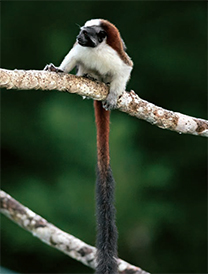
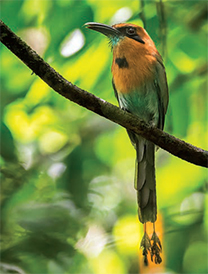
The Gamboa Rainforest is an exotic vacation sanctuary where individuals, groups and families can have memories to last a lifetime. At Gamboa in Panama everyone is welcomed into the heart of nature in the midst of one of South America’s richest rainforests. Seventy percent of the total population of 3.8 million people in Panama are Mestizo (people of mixed Indian and European ancestry) while the native Indians comprise of only 6%. Spanish is the dominant language and, according to my guide, only about 18% of Panamanians speak English fluently. But most of the people I met didn’t speak enough English to understand basic questions. Learn few words of Spanish (tips to survive in difficult situation where your google translator doesn’t work because of weak mobile network). Panama’s biodiversity is staggering – the country is home to 218 mammal species, 226 species of reptiles, 164 amphibian species and 125 animal species that are found nowhere else in the world. Panama also boasts 940 avian species, which is the largest number in Central America and Soberania National Park is the best place to do birding. With over 400 species of exotic birds, and more than 105 species of mammals, the park is a haven for wildlife enthusiasts, and a great way to spend a day hiking through the real Panamanian jungle when you are short of time. Panama’s geographical position also makes it a crossroads for migratory birds. From August to December, North American raptors migrate southwards into Central America by the millions –at times, there are so many birds that they make a black streak across the sky. Bird-watchers consider Panama to be one of the world’s best birding sight. Quetzals, macaws, amazons, parrots and toucans – all have sizable populations here, as do many species of tanager and raptor. Parque Nacional Soberanía (Soberania National Park), where hundreds of species have been spotted along the famous 17 kms long Pipeline Road. Primate lovers are also drawn to Panama. Among the country’s many species, the white-faced capuchins, squirrel monkeys, spider monkeys and howler monkeys are some fascinating varieties. The Geoffroy’s Tamarin, for instance, is found nowhere else in Central America. These tiny, gregarious monkeys can live in groups of up to 40 in lowland forest, and many weigh less than a pound. They’re identified by their whistles and chirps, mottled black-and-brown fur, white chests, and of course, their diminutive stature. I was lucky to see them and click them too. In Soberania National Park the southern end of Old Gamboa Road traverses a variety of habitats including developed areas, open country and remnant forests. It eventually reaches the Summit Ponds, which is a good location for seeing various aquatic birds. The northern end of the road continues from the Summit Ponds into more forested areas and offers access to forest dwelling birds including some birds not commonly seen elsewhere on the Pacific side of the canal zone. Unfortunately, access to the road is currently curtailed by construction related to widening the Panama Canal, so it is not generally accessible for birding during the foreseeable future. Many of the same birds seen along Old Gamboa Road can also be found along the nearby Pipeline Road, but the forest is somewhat drier and has a different species mix. This is the area where I saw the rare Black Hawk-Eagle. It is an especially good place to look for antbirds and other species that are obligatory followers of army ant swarms.
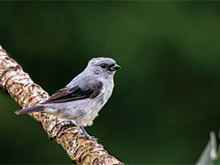
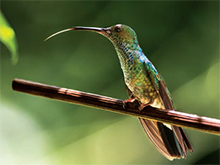
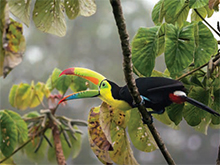
The town of Gamboa provides access to the famed Pipeline Road. There is also some birding around the Ammo Dump ponds and other areas around the town. It is the location of Gamboa Rainforest Lodge, which has limited birding on the premises but is the access point for taking a boat across an arm of Gatun Lake to an Embarra village. The Chagres River flows into Gatun Lake at Gamboa. This and other waterways around Gamboa provide habitat for the wetland birds. On the old Gamboa Road I was really keen to click the picture of Keel Billed Toucan (also known as Rainbow Billed Toucan) but I had hard luck. I could not click this beautiful bird because they were perched at faraway distances. Really upset, I started walking back towards the resort engrossed in my own thoughts and thinking how badly I wanted to capture the bird. As I walked, when there was still a bit of distance to cover, I saw a beautiful little Central American Agouti lost in its own thoughts in the wooded lands of the forest. I stopped immediately and without making any noise lied down on my chest on the ground to get the eye level shot of this beautiful mammal. It was difficult for me to click as I was facing the back of Agouti. Fortunately however I did not have to wait for long as it looked around, most probably for food and this gave me sufficient time to capture its beauty. Immediately after I had clicked the Agouti in different postures, I saw the Keel Billed Toucan too and was finally lucky this time to be able to click this amazingly beautiful and most colourful bird I have ever clicked. It was a real surprise for me, after I had got tired looking for the bird it came so close to me by itself. Sooner I captured Collared Aracari too, another beauty from this forest. Certainly this Agouti brought me luck. Thank you Agouti! Old Gamboa Road is the old road between the town of Gamboa and Panama City. This 4.4 km long road runs parallel to Gaillard Highway, which is the main road to Gamboa. At the Summit Gardens turnoff, one must turn left (instead of right to Summit Gardens), cross the railroad tracks, and then turn right a few hundred yards past the railroad tracks onto the road. The Summit Ponds are near the beginning of this road. Escaping into the lush embrace of Panama’s Soberania National Park Rainforest sweeps you to a five-star sanctuary of privacy, luxury and solitude. Your experience begins with uncomparable birding at Gamboa, with its unparalleled collection of birds. Travellers who have not yet treaded the route may note that distinctive, enchanting and inspiring birding takes place at the Soberania National Park, it keeps you moving!!!!
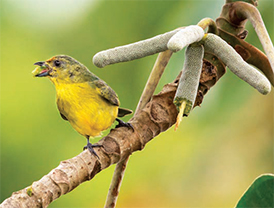
This was my perfect introduction to Central American birding. This beautiful and very accessible country offers a great diversity of neotropical bird species, many of which are very difficult to find elsewhere in the world. Excellent bird and animal watching locations can be easily accessed here and a difficult and arduous hike is not necessary to sight the animals. In addition to the incredible number of birds Panama has an impressive number of plants (10,000+), butterflies (16,000+), mammals (200+), frogs (190+) and numerous other surprises to discover. I am looking forward to another birding trip to Panama soon and Costa Rica in 2017. |SP

